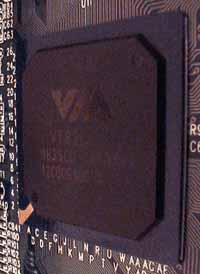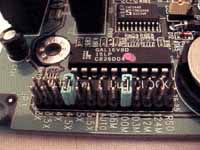Epox P2-112A Apollo Pro Pentium II Board
by Anand Lal Shimpi on October 2, 1998 2:23 PM EST- Posted in
- Motherboards
Anand Tech Report Card Rating 97/A
| CPU Interface | Slot-1 |
| Chipset | VIA Apollo Pro |
| L2 Cache | N/A (on-chip) |
| Form Factor | ATX |
| Bus Speeds | 66 / 75 / 83 / 100 / 103 / 112 / 124MHz |
| Clock Multipliers | 2.0x - 5.5x |
| Voltages Supported | Auto Detect |
| Memory Slots | 3 168pin DIMM Slots (EDO/SDRAM) |
| Expansion Slots | 1 AGP Slot 5 PCI Slots 2 ISA Slots (1 Shared / 2 Full Length) |
| BIOS | Award BIOS |
| In the past, all Pentium II motherboards could be referred to as either an Intel FX, LX or the newer Intel BX based motherboards. That will now change as two familiar contenders make their late entries into the Slot-1 chipset market, these two companies are Acer Labs Incorporated, known for their Socket-7 (Aladdin IV) and Super7 chipsets (Aladdin V) and the more popular VIA Technologies also known best for their Socket-7 (Apollo Series) and Super7 chipsets (Mobile Apollo Series). The first to finish the race to release a non-Intel chipset for the Pentium II platform in this case was VIA with their new Apollo Pro chipset. Although it may seem to be a new entry into the market, the Apollo Pro's design has been around for quite a while, originally intended for use with the Pentium Pro, VIA simply made minor modifications to the chipset and added support for newer technologies such as SDRAM and the Accelerated Graphics Port (AGP). It is this chipset that Epox's latest concoction, the P2-112A, was based around, introducing yet another factor into the world of Slot-1 motherboards, chipset manufacturer variations. |  |
| Starting off as just about any normal Slot-1 motherboard with its layout, the P2-112A features the same 5/2/1 expansion slot configuration (PCI/ISA/AGP) which brought incredible fame and fortune to ABIT with their BH6. The inclusion of 5 PCI slots provides ample room for expansion in the future with Ethernet cards, PCI Sound Cards, and secondary graphics accelerators among other things. The VIA Apollo Pro chipset brings full AGP 2X support to the game therefore outfitting the P2-112A with the increasingly popular AGP slot was no big of an ordeal. All slots present on the board can accept full length cards, this was made possible by two factors: the proper implementation of the ATX specification and the positioning of all front panel connectors out of the path of all of the expansion slots. |  |
 |
The PCB (Printed Circuit Board) the P2-112A is built upon is very well laid out as alluded to before with the expansion slot configuration, however the design also allows for a few trademark Epox features to be included at no PCB real estate cost to the user. Populated with electrolytic capacitors around the Pentium II's Slot-1 interface, as well as the DIMM slots and peripheral expansion slots, the stability of the board is well accounted for from an engineering sense. Common place on virtually all Epox motherboards is the Easy Set Jumper Setting configuration which allows you to configure the Front Side Bus Frequency and Clock Multiplier via a single jumper for each setting bringing the board's setup down to a level of ease previously thought impossible. The selectable FSB speeds include 66, 75, 83, 100, 103, 112, and 124MHz with a reserved setting, possibly for 133MHz. |
The P2-112A boasts Epox's unique ability to power on an ATX system via a keystroke combination on the keyboard instead of using the power button on your case, this option can be enabled by a combination of a single jumper and a BIOS setting.
The VIA Apollo Pro chipset also allows for operation of the SDRAM clock at a 1/1 or 2/3 ratio in reference to the CPU FSB Clock. This single jumper basically offers the same functionality as it did on motherboards based on the VIA MVP3 chipset, while your FSB may be set at 100MHz+ your memory clock will remain at or around 66MHz, breathing new life into your older SDRAM and EDO DIMMs which may not be able to cope with higher FSB settings. This can dramatically decrease the overall cost of your system if you have any DIMMs laying around. The performance hit for running your SDRAM at 66MHz while your FSB is clocked at 100MHz is around 1 - 2%, and hardly noticeable.
Classic of all Epox motherboards, the P2-112A doesn't skimp in terms of its documentation, especially in the explanation of the BIOS settings. Two specific BIOS settings, Auto Detect DIMM/PCI Clk and Spread Spectrum Modulated are designed to reduce electromagnetic interference (EMI) and result in increased stability. Those two settings can be found on the newest Award BIOS revisions on most motherboards.
As far as performance is concerned, the P2-112A gives the ABIT BH6 a good run for its money as it consistently produced Winstone scores on par with the BH6 as well as other BX based Pentium II mainboards.
Remember all of the problems the VIA MVP3 chipset had with its AGP port? Welcome back, the Apollo Pro brings you the same hassles if not handled properly. The AnandTech test system running Windows 98 didn't require any specific AGP or Bus Master drivers for proper operation, however Windows 95 users may find that without the VIA AGP GART drivers they'll be out of luck. The board had no problems with a G200 or a TNT based AGP graphics accelerator which is a big sigh of relief in comparison that the problems Super7 users had to face. This is simply because you aren't using a non-Intel processor with the motherboard, which does help tremendously in terms of conflicts especially with the earliest driver revisions of the TNT boards.
Other than that, the lack of any voltage adjustment features does set the P2-112A a bit behind in comparison the BH6 however Epox's obvious efforts to reduce EMI could definitely help improve stability somewhat in overclocked situations where EMI becomes a critical factor in stability.










0 Comments
View All Comments